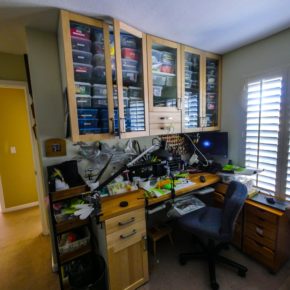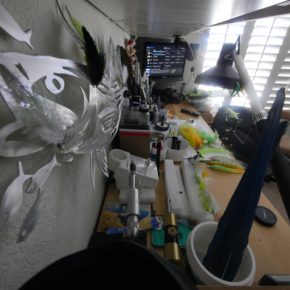I have been tying flies for 50 years. Between the age of 12 and 18, I tied commercially for the Millpond Fly Shop and Creative Sports Enterprise. I’ve tied many patterns developed by very talented fly fishermen. I have also met many fly tiers that claim to have exclusive rights to a fly pattern—even some claiming to have Intellectual Property Rights to a fly. I’ve seen flies with “Patent numbers” tied to them in which the tier claims “is necessary to the action of the fly”. I’ve seen groundbreaking original flies and I’ve seen flies that were the combination of old ideas, some my own, that tiers feel are their unique designs. There may have been a time when I felt a need for recognition for unique techniques, materials , or patterns that I may have been the first to experiment with , but at 60 years of age, fly tying has become a means to an end—that being catching more fish. I respect fly tying innovation and those ground breaking fly tyers deserve recognition if that is what hey seek. I for one do not seek that. Flies that I have tied and techniques that I use most likely have been done before even though they are new to me and I take no ownership or even claim that they are my original ideas. After a lifetime of reading old books on fly tying and studying the history of the art, I have been skeptical that there are any really new ideas about tying- just new materials. I don’t make a living tying flies and have not sold a fly in decades.
What I like to do is cut and paste any picture or photo of a fly I see that interests me. Like scrapbooking. I use to store them on this page so that I could remember what elements I might incorporate in my own flies for my own use. The flies I use are tied by myself and designed to my specific needs as they pertain to species, time of year and lines. If that pattern looks similar to your original pattern, I humbly thank you and may you be blessed for your contribution to the cloud of ideas that is fly tying. I would even welcome a comment with your claim to the pattern or technique– put your name on something so someone can challenge you as to the origin of that fly or technique. Anybody who has ever fished with me or knows me well, knows that I am generous with my flies and often give away more flies than I use. I make no claim that any of my flies are uniquely mine nor claim that any technique is originally mine such as “tying a rattle to a fly with EZ body” or “rear weighting a fly.”
Recently, I learned that there are some out there who are upset with me about posting pictures of flies that they tied without their permission. I did post flies that were tied by other people that I thought were interesting, primarily to use as a source of ideas. I posted my collection of gathered images for reference using google image searches and from posts on public forums. I’ve decided to remove any fly pictures in this collection from public view since there are a few people who find my not referencing them offensive. I apologize to those people for using images of their flies without reference or permission. I gained no profit from doing so. You can send your hate mail msyn@carabelli.com.
Perhaps the most popular Striper Flies of all time are variations on the Clouser. Most people credit Bob Clouser with its design but few people know that Joseph Bates referred to adding bead chain eyes to bucktails in the ‘40s. Tom Schmucker might be the first person to tie one since he is credited with first designing and building lead eyes for flies. Dan Blanton’s modification “the Flashtail Clouser” is also a great striper pattern and I remember tying them commercially in the 70s for the Millpond. But the funniest story I remember hearing was about a fly tying demonstration given by Bob Clouser as he was tying “his” fly. A flytier watching Bob tying the eyes in the middle of the hook and not knowing who the tier was, commented to him that he was doing it wrong. Bob joked, that all this time he was doing it wrong, thanked the guy who went on his way never knowing who he was talking to.
The flies posted on this page are tied by me, and I make no claim of ownership, original design, or any claim of commercial intellectual property. I’m just trying to catch more fish in my own way trying to learn and improve from others.
Click PIC for PW protected Fly Pattern Scrapbook










Great post Meng. Thank you for sharing your lifetime of knowledge openly and humbly. I’ve never understood the “proprietary” approach to either fly tying or fly fishing. It just goes against everything the sport means to me. Hopefully you’re not getting an excessive amount of “hate mail” for your approach. 🙂
Hello Meng, my name is Greg Smith, and I am with the Salinas Valley Fly Fishers, and we were hoping that in the future you could speak to our fly group about fishing San Luis. Please let me know if this will work for you. Our club meets the second Wednesday of the month at the Salinas Airport. Hope to hear from you, Greg Smith SVFF
Thanks Meng,I really appreciate all your help. I went out on sat. with my fishin’ bud, but we could not find any fish. We marked some bait fish, but no schools of stripers.I only got one light bump on a whistler, but that was it for the whole day.the water was still stained with only a foot or so of visibility. We called it quits around 4:00 pm. I think I will try Big San Louie the next time until I get some pulse disks.
Here is one quote to add to your quote list.
Age is an issue of mind over matter.
If you don’t mind,it doesn’t matter.
Mark Twain
Cheers,
Loren
What size pulse disk do you use on your flies when you fish the forebay? I am thinking about going this weekend,but I saw a post on Blanton’s bulletin board that the water was really stained and the pulse disk seems to have made a big difference. And where can you get some pulse disks on line?
Thanks,
Loren Kitamura
I like size 3’s and 4’s.
http://brineflyinnovations.com/index.php?page=determine-the-size-you-need